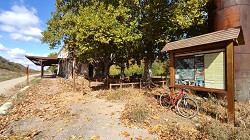| FC.Santander-Mediterráneo Greenway (Campo.de.Daroca-Jiloca) |
|

|
Between Murero and Ojos Negros in the provinces of Zaragoza and Teruel, by one of the iconic railways of the past: the Santander-Mediterranean railway until connecting with the Ojos Negros Greenway.
This Natural Way - Greenway has been implemented within the framework of the Natural Ways Programme of the Ministerio de Agricultura, Pesca y Alimentación. More info>>

|
| WRITE YOUR REVIEW
|
| Technical data
|
|
 CONDITIONED GREENWAY CONDITIONED GREENWAY
LOCATION
Between Murero and Ojos Negros, passing through the regions of Daroca and Jiloca to connect with the Ojos Negros Greenway.
Zaragoza and Teruel. ARAGON.
Municipalities: Murero, Manchones, Daroca, Villanueva de Jiloca, San Martín del Río, Báguena, Burbáguena, Calamocha, Fuentes Claras, Caminreal, Torrijo del Campo and Monreal del Campo.
Length: 69,5 km.
Users:    * The connecting sections between the Natural Way Greenway of FC. Santander Mediterráneo and the Ojos Negros Greenway may present more problems of slopes. * The connecting sections between the Natural Way Greenway of FC. Santander Mediterráneo and the Ojos Negros Greenway may present more problems of slopes.
Type of surface: compacted gravel.
|
|
|
|
Natural environment:
Jiloca river, irrigated agricultural land and riverside forest. The accompanying trees are acacias, ash trees, hawthorn, honeysuckles and poplars.
Cultural heritage:
Murero: The Cambrian Palaeontological site of Murero, the Parish Church and, next to the river, the Hermitage of Saint Mamés.
Manchones: Parish Church, two Hermitages (Saint Roque and Virgen del Pilar), and different architectural elements of interest like the public Washing Area, two 17th century stone fountains, Peirones, an acueduct on the railway, etc.
Daroca: Historic and artistic Conservation Area: Medieval Walls, towers and gates, Basílica of Saint Mary and Chapel of the Sacred Corporals (Sacred cloth with blodded Holy Hosts) and a 15th cetury Organ, ancient churches of Saint John, Saint Michael and Saint Dominic, the Nazaret Hermitage, Tunnel of La Mina (for hydraulic purpose), stately houses, museums, etc.
Villanueva de Jiloca: Parish Church of Saint Gil, two hermitages (Virgen del Rosario y San Bernabé), the 16th century stately home of the family Abad de Bernabé.
... and much more in the locations through which it passes: San Martín del Río, Báguena, Burbáguena, Calamocha, Fuentes Claras, Caminreal, Torrijo del Campo, Monreal del Campo.
Greenway, bridges, recreational areas, 1 tunnel, remains of the old railway (buildings, cranes, etc.) and connecting section by roads outside the railway platform to connect with the Ojos Negros Greenway.
How to get here
Train: Zaragoza and Calatayud stations. Tel. 912 320 320. Renfe.com.
Bus:
Jiménez bus company. Zaragoza - Teruel line. Stop at Villanueva de Jiloca.
Company Agreda bus. Line Molina de Aragón - Zaragoza. Stop in Daroca.
Company autocares Hermasa. Calatayud - Daroca line.
Taxi from Calatayud with bicycle transfer option.
Connections:
Zaragoza: 85.9 km from Daroca, 89.8 km from Murero, 87.2 km from Manchones and 91.2 km from Villanueva de Jiloca.
Calatayud: 37.8 km from Daroca, 31 km from Murero, 32, 8 km from Manchones and 43.1 km from Villanueva de Jiloca.
Greenway Managing Entity:
County of Campo de Daroca
Tel. 976 545 030
County of Jiloca
Tel. 978 730 637
Connections to other trails and routes:
|
|
|
|
|
|
| Railway History
|
|
Photo: Railway Historical Archive of the Railway Museum of Madrid(GARCÍA ÁLVAREZ, ALBERTO)
|
The Calatayud-Valencia Line was a Spanish railway line that ran through Aragon and Levante, linking Calatayud with Teruel and Valencia. It reached a length of 300 kilometers, crossing several provinces. At present time this line has been dismantled.
Along the 19th century there were several intitiatives to build a railway to link Aragón con Valencia and Levante although many of those projects never materialized. It would not be until the 1890s when the construction of a railway line connecting Calatayud with Valencia through Teruel beganby the Compañía del Ferrocarril Central de Aragón, established in 1894 by Belgian businessmen.
|
Due to the complexity of the terrain, the construction took several years and was finished by sections: Sagunto- Segorbe, on May 15, 1897; Segorbe - Jérica, on June 1, 1899; Jérica - Barracas, on December 29, 1899; Barracas - Puerto Escandón, on November 3, 1900. The next section, Puerto Escandón - Calatayud, would be completed on June 28, 1901. The following year, on March 8, 1902, the rail link between Sagunto and Valencia was completed.
The beginning of the line was the Calatayud - Jiloca station, while the terminal station was the Valencia - Alameda station. Other important train stations were located in Daroca, Caminreal, Teruel and Sagunto-Amphitheater.
The Daroca train station began its service in June 1901 with an important passenger and freight activity. In 1929 it was the second railway station to transport more tonnage of cereal in Spain.
In 1941 became part of RENFE (Spanish National Railway Network) but, due to the demographic decline of the region, the Calatayud-Caminreal section stopped providing service on January, 1st 1985.
|
|
|
|
|
|
|
